August 15-22, 2001
The Big Travelogue: Part Three
There's nothing like a good road trip to get a feel for the
state of radio these days. From June 23 until July 7, your editor
(accompanied by Boston Radio Archives creator Garrett Wollman)
hit the road to see what's on - and in - the air across a broad
swath of mid-America.
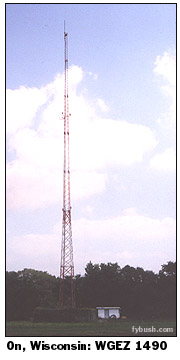 For the next few
installments of Site of the Week, we'll be recapping the many
highlights of what we like to think of as The Big Trip, 2001
edition. Come along... For the next few
installments of Site of the Week, we'll be recapping the many
highlights of what we like to think of as The Big Trip, 2001
edition. Come along...
Click
here for part one
Click
here for part two
We begin this episode on the same day on which we left off
Part Two, Tuesday, June 26, heading west out of Chicago on I-90
on a pointless quest to add one more state to the itinerary.
Passing through the edges of the Rockford area, we crossed into
Wisconsin just long enough to eat lunch and snap a picture of
the one and only tower we'd see in the Badger State: WGEZ, 1490
on your dial in Beloit.
There it is at the right, and it's just barely in Wisconsin;
a few hundred feet south on old US 51 and we were back in Illinois
for a few hours of Rockford-market tower hunting.
The AM towers of Rockford weren't all that exciting, really:
a single stick for WLUV 1520 in Loves Park and its FM counterpart
on 96.7, three towers for WROK 1440 at the studio complex that
houses it, WZOK 97.5 and another FM, and two towers on the south
side of town for WNTA 1330 (agaon, just above the studio building
for WNTA and its FMs). We didn't see the South Beloit-licensed
1380, WTJK. Somewhere in the midst of the day, your editor even
managed to tape over a few of the Rockford IDs, so at some point
I'll probably have to head back there.
 Heading out to the
west side of town, Rockford's TV stations are all tightly clustered
just north of US 20 where the new bypass meets the old road.
Each (with the exception of Fox outlet WQRF, channel 39) has
the same basic layout: big piece of land, long driveway, tall
guyed tower, small studio building at the base. Heading out to the
west side of town, Rockford's TV stations are all tightly clustered
just north of US 20 where the new bypass meets the old road.
Each (with the exception of Fox outlet WQRF, channel 39) has
the same basic layout: big piece of land, long driveway, tall
guyed tower, small studio building at the base.
Rockford is mostly a UHF market; to the left you see ABC affiliate
WTVO (Channel 17), just south of CBS affiliate WIFR (Channel
23), which is licensed to nearby Freeport. They don't get PBS
locally in Rockford (I'm guessing Chicago's WTTW or Madison's
WHA-TV are the cable choices), and UPN comes by way of WHPN,
channel 57, in Janesville, Wisc., which is really a Madison-market
station. (If we'd had an extra day, we would no doubt have made
Madison and perhaps Milwaukee additional stops on the trip...)
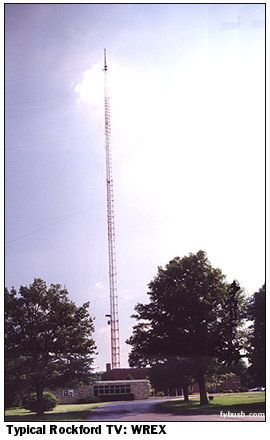 That leaves one
VHF outlet in Rockford: WREX-TV, channel 13, the NBC affiliate.
It's about a mile west of the channels 17, 23 and 39 sites in
that cluster west of downtown Rockford, and as you can see, it
follows that pattern of tower-and-building that's so common in
the midwest. That leaves one
VHF outlet in Rockford: WREX-TV, channel 13, the NBC affiliate.
It's about a mile west of the channels 17, 23 and 39 sites in
that cluster west of downtown Rockford, and as you can see, it
follows that pattern of tower-and-building that's so common in
the midwest.
So where were we? It was getting late in the day, and there
were still miles to go before we could get to the Quad Cities
and get some rest.
So off we headed on US 20, up and down the hills (it seemed
shorter on the map!), past Freeport (where we heard the 1570
signal and caught a glimpse of the tower from the road) en route
to Dubuque.
Did we mention the hills? Illinois gets very uneven as it
makes its way to the Mississippi River, and radio reception was
just as uneven for much of the drive, not that there was much
to listen to in northwestern Illinois anyway.
After another year or so of driving (well, two hours anyway),
we were finally within sight of the Mississippi, dropping down
towards the river on the Illinois side to see the four towers
of KDTH 1370, one of Dubuque's two AM outlets. (The other, WDBQ
1490, didn't do a legal ID and we didn't bother to check out
its tower on the Iowa side...)
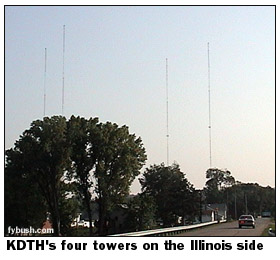 You
can't see it clearly in this picture, but KDTH built its transmitter
in the bottomlands along the river, with a transmitter building
elevated a story or so above the ground to protect it from the
inevitable flooding. (I'm told it works, too...) You
can't see it clearly in this picture, but KDTH built its transmitter
in the bottomlands along the river, with a transmitter building
elevated a story or so above the ground to protect it from the
inevitable flooding. (I'm told it works, too...)
High school sports were the order of the day on 1370, (complete
with an actual legal within a minute of the top of the hour!)
and a visit to KDTH was the next order of the day for the Big
Trip crew.
Actually, we should say that a visit to KATF was the order
of the day, since an invitation from KATF assistant program director/afternoon
jock Brian Davis was our impetus to make the Dubuque detour from
our original Chicago-Quad Cities agenda. KATF, a class C blowtorch
at 92.9, is the longtime sister station of KDTH (the "TH"
stands for the Dubuque Telegraph-Herald, whose building
sits just across the street from the KDTH studios, though the
station and the paper are no longer co-owned).
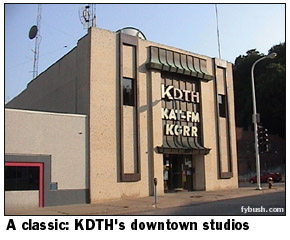 There's
a third, more recent addition to this building in downtown Dubuque
(all of which sits along a narrow slope heading down to the river
and stretching perhaps a dozen blocks north of the US 20 bridge
back to Illinois). KGRR (97.3) is the rock station that was recently
added to this locally-owned group; and now we've nearly listed
everyone who was live and local during our brief stop in Dubuque. There's
a third, more recent addition to this building in downtown Dubuque
(all of which sits along a narrow slope heading down to the river
and stretching perhaps a dozen blocks north of the US 20 bridge
back to Illinois). KGRR (97.3) is the rock station that was recently
added to this locally-owned group; and now we've nearly listed
everyone who was live and local during our brief stop in Dubuque.
The other group in town is a Cumulus cluster, including KLYV
(105.3) doing CHR against KATF and WJOD (103.3) doing country
against, well, Cumulus sister WDBQ-FM (107.5).
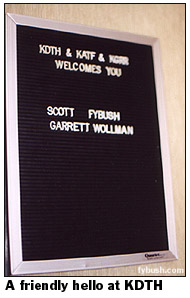 But
we came to see KDTH and KATF and KGRR, which is a good thing,
because it seems they were expecting us (thanks, Brian!) But
we came to see KDTH and KATF and KGRR, which is a good thing,
because it seems they were expecting us (thanks, Brian!)
It's not often these days that you see a radio facility that
was built in the late forties and hasn't been substantially altered,
but that's just what we found at the KDTH complex.
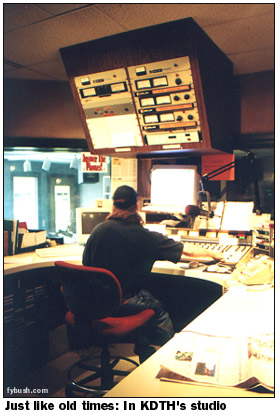 At
the heart of the building, elevated a couple of feet above the
rest of it no less, sits the KDTH main air studio. You just have
to love that overhead turret with the Belar mod monitors, don't
you? At
the heart of the building, elevated a couple of feet above the
rest of it no less, sits the KDTH main air studio. You just have
to love that overhead turret with the Belar mod monitors, don't
you?
The KATF studio occupies what used to be a news booth, through
the darkened window at the right of this picture (now it can
be told: Brian's last hour or so was voicetracked while we got
the grand tour...)
KGRR is in another booth at the left of the picture, and just
beyond that door is the newsroom, where KDTH still maintains
a full-time staff of three newspeople doing (gasp!) local news
all day long. An anachronism? Maybe...but KDTH regularly cracks
a 10 share, 12-plus, so they're doing something right in Dubuque.
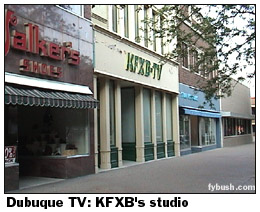 How about a little
TV? Dubuque used to have its very own ABC affiliate, KDUB-TV
Channel 40, with CBS and NBC being seen at a distance from Cedar
Rapids/Waterloo (about 50 miles west), Davenport (about 60 miles
south) and other far-off points. How about a little
TV? Dubuque used to have its very own ABC affiliate, KDUB-TV
Channel 40, with CBS and NBC being seen at a distance from Cedar
Rapids/Waterloo (about 50 miles west), Davenport (about 60 miles
south) and other far-off points.
A few years ago, KDUB was sold to Cedar Rapids Fox outlet
KFXA (Channel 28), and Peter Jennings gave way to Bart Simpson
for Dubuque viewers. The local news was the only thing that remained,
and to this day KFXA and the renamed KFXB split their simulcast
nightly at 6 and 10 for local Dubuque news on channel 40. Those
are the studios, in a storefront on what has to be the deadest
pedestrian mall I've ever seen. Today, Dubuque is part of the
Cedar Rapids/Waterloo TV market and gets all its "big-3"
network service from those stations, at least on cable.
We headed south from Dubuque with about 90 minutes remaining
before sunset on one of the longest days of the summer, rolling
down US 61 towards the Quad Cities with one more stop to make.
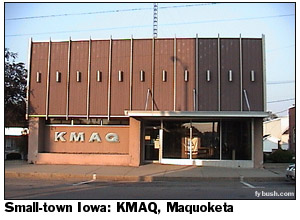 Having
seen the former WMAQ in Chicago just the day before, it
seemed somehow important to view KMAQ as well, and so
we did during a brief stop in the bucolic Iowa town of Maquoketa
(that's Muh-QUOE-ke-tah, in case you're curious!) Having
seen the former WMAQ in Chicago just the day before, it
seemed somehow important to view KMAQ as well, and so
we did during a brief stop in the bucolic Iowa town of Maquoketa
(that's Muh-QUOE-ke-tah, in case you're curious!)
The studios are downtown; the tower is northeast of town,
carrying KMAQ on 1320, which was doing standards, and KMAQ-FM,
recently relocated from 95.3 to 95.1 and carrying Cubs baseball.
The signal on 95.1 must still be in test mode; it was weak and
poorly modulated, even within sight of the tower.
And from Maquoketa, we raced the sunset south to Davenport
and Moline -- but that's a tale for Part Four, coming next week!
|
